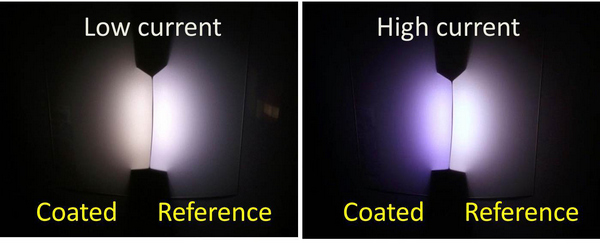When the 2014 Nobel Prize in physics was awarded this October to three Japanese-born scientists for the invention of blue light emitting diodes (LEDs), the prize committee declared LED lamps would light the 21st century. Now researchers from the Netherlands have found a novel way to ensure the lights of the future not only are energy efficient but also emit a cozy warmth.
“We demonstrated a seemingly simple – but in fact sophisticated – way to create LED lights that change in a natural way to a cozy, warm white color when dimmed,” said Hugo Cornelissen, a principal scientist in the Optics Research Department at Philips Research Eindhoven, a corporate scientific research entity owned by the company Royal Philips in the Netherlands.
 |
|
At low current the coated LEDs emit a cozy, warm glow compared to uncoated reference LEDs. (Photo Credit: Hugo J. Cornelissen) |
Cornelissen and his colleagues from the Eindhoven University of Technology, Netherlands describe their new LEDs in a paper published today in The Optical Society’s (OSA) open-access journal Optics Express.
Incandescent lamps naturally emit warmer colors when dimmed, and Cornelissen said our general preference for redder colors in low-light situations might even have developed far back in time, when humans “experienced the daily rhythm of sunrise, bright daylight at noon, and sunset, each with their corresponding color temperatures.”
LEDs, however, don’t normally change color at different light intensities. Other groups have used multiple color LEDs and complex control circuitry to make lights that turn redder as the power is turned down. The added complexity comes with its drawbacks: multiple components can increase the cost and the risk of failure, and mixing the light from multiple LEDs without creating color shadows and other light artifacts is a tricky business.
The Dutch research team tried an entirely different approach to creating cozy LEDs. The scientists had noticed that when they embedded LEDs in coated textiles or transparent materials, the color of the emitted light would sometimes change.
“After finding the root cause of these effects and quantitatively understanding the observed color shift, we thought of a way to turn the undesired color changes into a beneficial feature,” said Cornelissen.
Starting with White LEDs
They began with cold white LEDs, which can be made from blue LEDs surrounded by a material known as a phosphor. Part of the blue light is absorbed by the phosphor and re-emitted at a different color. The multiple colors combine to form white light.
Cornelissen and his colleagues knew that the color of the white light could be shifted toward the warmer end of the spectrum if more of the blue light is absorbed and re-emitted by the phosphor. What they describe in the new paper is how they developed a novel – and temperature-dependent – way to create this shift.
The scientists made a coating from a composite of liquid crystal and polymeric material. The composite normally scatters light, but if it is heated above 48 degrees Celsius (approximately 118 degrees Fahrenheit), the liquid crystal molecules rearrange and the composite becomes transparent.
When the team covered white LEDs with the coating and turned up the power, the temperature increased enough to make the coating transparent, and the LEDs emitted a cold white color. When the power was turned down, the coating reorganized into a scattering material that bounced back more of the blue light into the phosphor, generating a warmer glow.
The scientists later fine-tuned the LED design and used multiple phosphors to create lights that comply with industry lighting standards across a range of currents and colors.
“We might see products on the market in two years, but first we’ll have to prove reliability over time,” Cornelissen said. “That is one of the important things to do next.”
The team believes the new lights could help speed up the acceptance and widespread use of LED technology, especially in the household and hospitality markets, “where there is a need to create a warm and cozy atmosphere,” Cornelissen said.
Paper: “Thermoresponsive scattering coating for smart white LEDs,” J. Bauer et al., Optics Express, Vol. 22 Issue S7, pp. A1868-A1879 (2014). ARTICLE LINK: http://www.opticsinfobase.org/oe/abstract.cfm?uri=oe-22-S7-A1868












